#frank bullitt
Explore tagged Tumblr posts
Text

#favorite character bingo#golgo 13#trigun#vash the stampede#vampire hunter d#wicked city#renzaburo taki#demon city shinjuku#kyoya izayoi#fist of the north star#kenshiro#rei fist of the north star#raoh#bullitt#frank bullitt#dirty harry#harry callahan#get carter#jack carter#die hard#john mcclane#the transporter#frank martin#léon the professional#léon#james bond#speed 1994#jack traven#john wick#the matrix
20 notes
·
View notes
Text
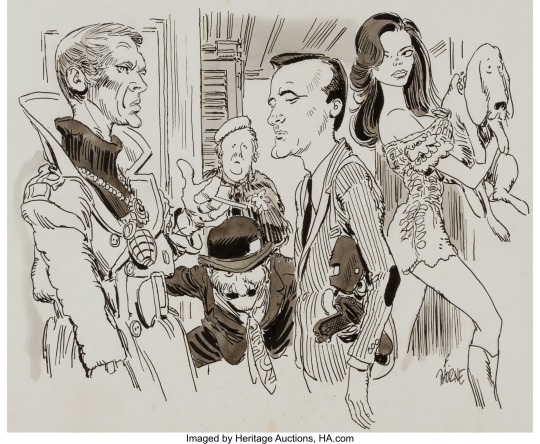
Frank Thorne - Man From UNCLE Illustration Original Art (c. 1960s) Source
“Frank Thorne depicts the three main characters - played by Steve McQueen, Robert Vaughn and Jacqueline Bissett - from the 1968 thriller Bullitt. Unknown usage, but likely from a magazine parody.”
12 notes
·
View notes
Text
sorry i woke up thinking about drive me crazy for some reason. hunt is so corny why would he reference frank bullitt. well because he's corny. what has always been stupid to me is that mc doesn't know who frank bullitt is. girl aren't you in film school
#funnier if the character is a director major. girl what do you mean you don't know who frank bullitt is#<- always sooo funny when mc doesn't know film history in hwu. buddy where's your curiosity. your whimsy. love for the craft#i get hunt a lot actually i'm not gonna lie. i hate him but it's because i get him
1 note
·
View note
Text
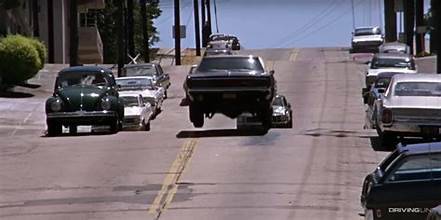
"Bullitt" (1968) was director Peter Yates' first American film. He was hired after Steve McQueen saw his 1967 U.K. feature "Robbery," with its extended car chase. Joseph E. Levine, whose Embassy Pictures had distributed "Robbery," did not like the film much, but Alan Trustman, who saw the picture the week he was writing the "Bullitt" chase scenes, insisted that McQueen, his Solar Productions partner Robert Relyea and producer Philip D'Antoni (none of whom had ever heard of Yates) see "Robbery" and consider Yates as director for "Bullitt."
Bullitt is notable for its extensive use of actual locations rather than studio sets, most notably the city of San Francisco, California, and its attention to procedural detail, from police evidence processing to emergency-room procedures. Yates' use of the new lightweight Arriflex cameras allowed for greater flexibility in location shooting.
At the time of the film's release, the exciting car chase scenes featuring McQueen at the wheel in all driver-visual scenes generated prodigious excitement. Film critic Leonard Maltin has called it a "now-classic car chase, one of the screen's all-time best." Fellow critic Emanuel Levy wrote in 2003, "'Bullitt' contains one of the most exciting car chases in film history, a sequence that revolutionized Hollywood's standards."
Drivers' point-of-view shots were used to give the audience a participants' feel of the chase. Filming took three weeks, resulting in 9 minutes 42 seconds of pursuit. McQueen, a world-class racecar driver at the time, drove in the close-up scenes, while stunt coordinator Carey Loftin, stuntman and motorcycle racer Bud Ekins, and McQueen's usual stunt driver, Loren Janes, drove for the high-speed parts of the chase and performed other dangerous stunts.
Billy Fraker, the cinematographer for the film, attributed the success of the chase sequence primarily to the work of the editor, Frank P. Keller.
The editing of the scene was not without difficulties. Noted editor Ralph Rosenblum wrote in 1979, "Those who care about such things may know that during the filming of the climactic chase scene in 'Bullitt,' an out-of-control car filled with dummies tripped a wire which prematurely sent a costly set up in flames, and that editor Frank Keller salvaged the near-catastrophe with a clever and unusual juxtaposition of images that made the explosion appear to go off on time." (Wikipedia)
#car#cars#muscle car#american muscle#mopar#ford#moparperformance#moparnation#moparworld#chevrolet#movie cars#movies
62 notes
·
View notes
Text


Here's more web weaves for @mcytblraufest 2024! This is for my wonderful writer Pancho!! Sentinel and Guide AUs are some of my favourite soulmate tropes and smalletho fit them so perfectly so please check out their fic here!
The Five Senses and Etho by @pancho-pinto
A day to day in the life of a Sentinel can be rather spontaneous, no two days the same with all the input of sensory information from the world. With their extraordinarily acute senses, Sentinel's are expected to know how to handle them, their Guides always there to aid them when needed. And Joel, best of the best, has everything under control. For the most part. And that is where Etho comes in. or: An exploration/study of the individual senses from a Sentinel's perspective. And one from the perspective of the Guide.
Credits below the cut!
The Lunch Table (1944) - Susan Ryder | Volta - The Crane Wives Isolated silhouette of a couple slow dancing - Noel Powell on Shutterstock | Kiss (1897) - Edvard Munch | I don't know if love's a feeling... - Marguerite Duras | I choose to love you in silence... - Rumi | Sentinel AU on fanlore | I want to know what's... - @titsay | Diner Booth - captjackhaddock on reddit | Futon (1966) - Duane Keiser | quote from @leoworld | The little things? - Jon Kabat-Zinn | asofterworld comic | Human Inner Ear Anatomy Diagram - fineartamerica | sound wave collection (edited)
Fair - The Amazing Devil | Canary Wharf - Glyn Macey | you are not chained to the ones you love (edited) - @archbudzar | New York (2011) - Lennarts Dotter Olausson | Bullitt (1962) - Frank Gregory | And the Hound - Yaelokre | Embrace - Peter Wever | Absence XVII (2017) - Luciano Goizueta | tumblr post - @eddiegettingshot | ONE HUNDRED SLEEPLESS NIGHTS 1 (2017) - Andrea Vandoni | Jane Eyre - Charlotte Brontë
26 notes
·
View notes
Text
The King of Cool...
1968 / les assassinats de Martin Luther King Jr. et Robert F. Kennedy met les États-Unis dans le deuil et le chaos, des émeutes étincelantes.
Manifestations étudiantes massives contre la guerre du Vietnam à travers le pays. Au cinéma, "2001 : Une Odyssée de l'espace " de Stanley Kubrick est acclamée par sa vision futuriste et sa réflexion sur l'humanité.
Steve McQueen laisse une impression durable avec le rôle du Lieutenant Frank Bullitt, solidifiant encore sa réputation de star de l'action.
22 notes
·
View notes
Text
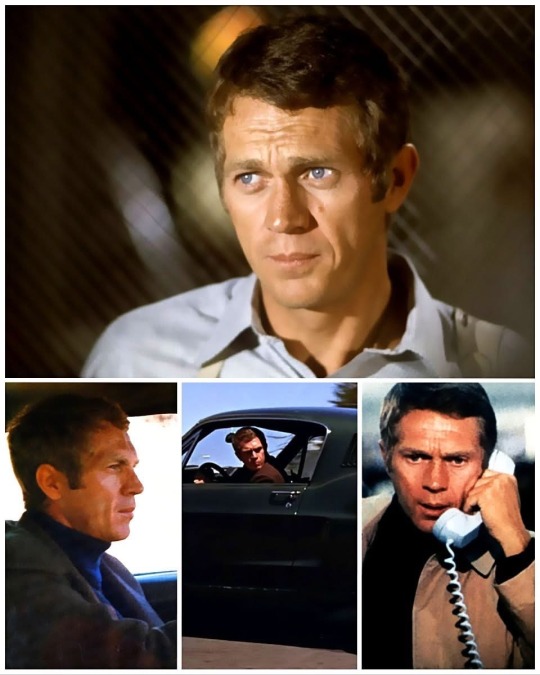
The unforgettable car chase in "Bullitt," featuring Steve McQueen racing through the streets of San Francisco in a Ford Mustang GT 390 Fastback, was not only a cinematic milestone but a direct result of McQueen’s insistence on authenticity and realism. His passion for driving and attention to detail shaped every frame of the film’s most iconic sequence, ensuring it would leave an indelible mark on Hollywood action filmmaking.
Steve McQueen’s involvement in "Bullitt" began when he was drawn to the gritty realism of Robert L. Fish’s novel "Mute Witness," which served as the basis for the film. He envisioned his character, Frank Bullitt, as a departure from the stereotypical police roles of the era, opting instead for a more grounded and understated portrayal. McQueen collaborated closely with director Peter Yates to bring this vision to life, insisting on an authentic depiction of police work and urban life in San Francisco.
The centerpiece of "Bullitt" was its groundbreaking car chase, a sequence that would redefine the action genre. McQueen, an avid racing enthusiast, was adamant about performing many of his own stunts. He personally selected the Ford Mustang GT 390 Fastback for his character, preferring its rugged, no-nonsense look over flashier vehicles. His hands-on approach extended to the chase’s choreography, as he worked with stunt coordinator Carey Loftin and drivers like Bud Ekins and Bill Hickman to craft a sequence that felt raw and unscripted.
Filming the chase was an ambitious and painstaking process. The production shut down sections of San Francisco’s famously steep streets, capturing dynamic shots of the Mustang and Dodge Charger weaving through traffic, jumping over hills, and skidding around corners. McQueen drove in many of these scenes, though Ekins performed the riskiest maneuvers. The intensity of the chase was heightened by innovative camera work, with director Peter Yates placing cameras inside and outside the vehicles to immerse viewers in the action.
One of the most striking aspects of the chase was its sound design. Instead of a traditional score, McQueen and the filmmakers opted to emphasize the visceral sounds of roaring engines, screeching tires, and crashing metal. This decision added a layer of realism that drew audiences into the action, making them feel as though they were in the driver’s seat alongside McQueen.
Despite its seamless appearance on screen, the chase was fraught with challenges during production. Mechanical failures, logistical hurdles, and near-misses added to the tension on set. McQueen’s insistence on realism often pushed the crew to their limits, but his commitment paid off. The resulting sequence felt alive and unpredictable, a testament to the dedication of everyone involved.
Beyond the chase, McQueen’s portrayal of Frank Bullitt was equally impactful. His understated performance, paired with his signature cool demeanor, made Bullitt a multidimensional character who resonated with audiences. From his carefully chosen wardrobe, featuring the now-iconic turtleneck and tweed jacket, to his quiet intensity, McQueen crafted a character that was as stylish as he was relatable.
When "Bullitt" premiered, the film was hailed as a masterpiece, with the car chase becoming its defining moment. Critics praised McQueen’s performance and the innovative approach to action sequences, which set a new benchmark for Hollywood thrillers. The chase has since become one of the most celebrated moments in cinema history, inspiring countless films and solidifying McQueen’s status as the "King of Cool."
Steve McQueen’s dedication to authenticity and innovation in "Bullitt" did more than elevate the film; it transformed action filmmaking. The legendary car chase, crafted with precision and passion, remains a high-octane thrill ride that continues to captivate audiences and set the gold standard for the genre.
7 notes
·
View notes
Text
My Top Ten Car Movie Scenes
Popularity can vary based on personal preferences, so I'll provide a list of ten iconic car movie sequences that have been well-received by audiences and critics over the years. Please note that these rankings are my opinion.
Bullitt (1968) - The Chase Scene
youtube
Summary: The iconic car chase in "Bullitt" features Steve McQueen as Detective Frank Bullitt pursuing two hitmen through the streets of San Francisco in a Ford Mustang GT 390 and a Dodge Charger. It's often regarded as one of the most influential and realistic car chases in cinematic history.
Vanishing Point (1971) - The Entire Movie
youtube
Summary: "Vanishing Point" is a cult classic that centers around a Vietnam War veteran, Kowalski, who bets that he can deliver a 1970 Dodge Challenger from Colorado to San Francisco in record time. The entire film is essentially one long and intense car chase across the American Southwest.
The Italian Job (1969) - Mini Cooper Heist
youtube
Summary: In this classic heist film, a group of thieves led by Michael Caine uses a fleet of Mini Coopers to steal gold bars in a high-stakes robbery in Turin, Italy. The Mini Cooper car chase through the narrow streets and tunnels of the city is a standout moment.
Ronin (1998) - The Paris Chase
youtube
Summary: "Ronin" is known for its intense and realistic car chase scenes. The most famous one takes place on the streets of Paris, where a group of international mercenaries engages in a high-speed pursuit involving several luxury cars.
Gone in 60 Seconds (2000) - The Eleanor Chase
youtube
Summary: In this remake of the 1974 film, a skilled car thief played by Nicolas Cage attempts to steal 50 high-end cars in one night. The standout chase scene involves "Eleanor," a highly modified 1967 Ford Mustang GT500, as Cage's character attempts to evade the police.
The Fast and the Furious (2001) - The Race Wars
youtube
Summary: "The Fast and the Furious" franchise is known for its high-octane car sequences, but one of the most memorable scenes from the first film takes place at the Race Wars, an illegal street racing event. It's a showcase of flashy cars and intense racing.
Death Proof (2007) - The Final Car Chase
youtube
Summary: Quentin Tarantino's "Death Proof" features a thrilling car chase in the final act, where a group of women pursues a murderous stuntman in a "death-proof" stunt car. The chase is filled with suspense and well-executed stunts.
Baby Driver (2017) - Opening Heist
youtube
Summary: "Baby Driver" opens with a high-energy car chase where the protagonist, Baby, showcases his exceptional driving skills while evading the police after a bank robbery. The entire film is known for its synchronization of action to music.
Drive (2011) - The Elevator Escape
youtube
Summary: "Drive" features a suspenseful car chase where Ryan Gosling's character attempts to escape from pursuers in an elevator. The scene is characterized by its tense atmosphere and minimalist approach to action.
Fast Five (2011) - The Vault Heist
youtube
Summary: In "Fast Five," the crew pulls off a daring heist involving a massive vault attached to two Dodge Chargers. The scene is notable for its sheer audacity and destruction as the vault is dragged through the streets of Rio de Janeiro.
These car movie sequences have left a lasting impact on cinema and continue to be celebrated by car enthusiasts and film lovers alike.
6 notes
·
View notes
Text
Steve McQueen’s Quintessential Thriller: Review of Bullitt (1968)
Steve McQueen’s Quintessential Thriller: Review of Bullitt (1968)
Synopsis- Lieutenant Frank Bullitt investigates a botched witness protection assignment that leads to a tense cat-and-mouse chase through San Francisco, culminating in one of cinema’s most iconic car chases. Director- Peter Yates Cast- Steve McQueen, Robert Vaughn, Jacqueline Bisset Genre- Action | Thriller Released- 1968 ⭐⭐⭐⭐⭐ Rating: 4.5 out of 5. Peter Yates’ Bullitt (1968) is a sleek,…
#1960s Cinema#Action#★★★★#★★★★★#cinema#film review#Film Reviews#Jacqueline Bisset#movie review#Peter Yates#Robert Vaughn#Steve McQueen#Thriller
0 notes
Text
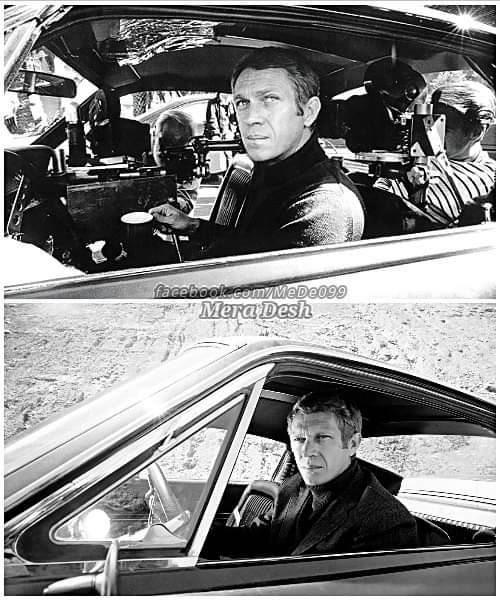
In the opening chase sequence of "Bullitt" (1968), a dark green 1968 Ford Mustang GT tears through the steep, undulating streets of San Francisco. The roar of the engine echoes off brick walls as Steve McQueen’s Lieutenant Frank Bullitt tightens his grip on the wheel. This electrifying scene isn’t just a cinematic moment; it’s a masterclass in coordination, precision, and raw power that has since redefined the action genre. But creating such an iconic sequence and the movie as a whole was no easy feat.
The production of "Bullitt" was as intense and gripping as the film itself. Directed by Peter Yates, a British filmmaker known for his work on "Robbery" (1967), the film was a leap into uncharted territory for American cinema. Yates’s expertise in staging realistic car chases was one of the key reasons McQueen fought to bring him on board. McQueen, who also served as the film's co-producer, was deeply involved in every aspect of the production, ensuring that "Bullitt" reflected his vision of an uncompromisingly cool and gritty detective story.
The screenplay, written by Alan R. Trustman and Harry Kleiner, was based on the novel Mute Witness by Robert L. Fish. The film retained the core story but took creative liberties to suit the cinematic format. McQueen envisioned Frank Bullitt as the embodiment of realism someone who could exist in the real world of law enforcement, without the theatrical flair often seen in Hollywood's portrayal of cops.
One of the standout elements of "Bullitt" is its setting. San Francisco wasn’t just a backdrop; it was a character in its own right. The city’s steep hills and narrow streets provided a natural stage for the now-legendary car chase. To capture the city’s essence, Yates worked closely with cinematographer William A. Fraker. They employed handheld cameras, unique angles, and a subdued color palette to create a gritty, almost documentary-like aesthetic. The result was a visual style that was both grounded and striking.
Of course, no discussion of "Bullitt" would be complete without diving into the 10-minute car chase that has become one of the most celebrated sequences in film history. Filming this scene was an enormous challenge that required weeks of preparation. The cars the Mustang GT driven by McQueen and a black Dodge Charger R/T were modified to handle the rigorous demands of the chase. McQueen, known for his love of racing and stunts, insisted on driving the Mustang himself for most of the sequence. His passion for authenticity pushed the crew to their limits, as McQueen wanted the audience to feel the speed, danger, and adrenaline.
The sequence was meticulously planned but executed with a sense of controlled chaos. Legendary stunt coordinator Bill Hickman, who also played the driver of the Charger, was instrumental in choreographing the chase. Hickman, along with McQueen and Yates, worked out every skid, jump, and hairpin turn, ensuring that the action felt spontaneous yet cohesive. To capture the speed and danger up close, camera rigs were mounted on the cars, and chase vehicles with cameramen strapped in captured the high-speed action. The result was a visceral, pulse-pounding experience that left audiences on the edge of their seats.
Behind the scenes, McQueen’s perfectionism sometimes clashed with the production schedule. He demanded multiple takes of certain scenes, particularly during the chase, to ensure every shot was flawless. This dedication extended to his wardrobe as well. McQueen worked with costume designer Theadora Van Runkle to craft Frank Bullitt’s iconic look most notably, the turtleneck sweater and tweed blazer that became synonymous with McQueen’s cool, understated style.
The film’s soundtrack, composed by Lalo Schifrin, also played a crucial role in defining its tone. Schifrin's jazz-inspired score underscored the tension and rhythm of the film, particularly during the quieter moments. His use of brass instruments and syncopated rhythms created an atmosphere that was both edgy and sophisticated.
Production wasn’t without its challenges. Filming in San Francisco came with logistical hurdles, as the city’s bustling streets and steep terrain posed risks to both the crew and equipment. The city itself, however, was highly cooperative, granting the filmmakers access to key locations. The final chase sequence was shot in multiple parts of the city, with clever editing stitching together footage to make the geography seem seamless. Observant viewers may notice that the cars pass the same landmarks more than once, a minor continuity issue that has since become part of the film’s charm.
Despite the meticulous planning, there were moments of genuine danger. During one high-speed section of the chase, a camera car was nearly hit, and on another occasion, a stunt driver lost control momentarily. These incidents only added to the adrenaline-fueled atmosphere on set, with every participant acutely aware that they were creating something groundbreaking.
The film’s final hospital sequence, which ends with Bullitt facing off against the villain on the tarmac at San Francisco International Airport, also required careful coordination. The airport granted the production limited access to its facilities, and the crew had to work quickly to capture the tense, climactic showdown without disrupting actual airport operations.
1 note
·
View note
Text
Steve McQueen: The King of Cool and Hollywood’s Iconic Rebel
Few actors have left as indelible a mark on Hollywood as Steve McQueen. Dubbed the “King of Cool,” McQueen captivated audiences with his gritty performances, effortless charisma, and undeniable screen presence. His life and career were a blend of rebellion, charm, and raw talent, making him an enduring symbol of masculinity and toughness in the 1960s and 70s. Whether racing through the streets of San Francisco in Bullitt, or outwitting the Nazis in The Great Escape, McQueen’s roles reflected the rugged individualism that defined him as both a star and a cultural icon.
McQueen’s life off-screen was just as fascinating as the characters he portrayed. A man who lived on the edge, he was a rebel in Hollywood and an adventurer in life, embodying a sense of freedom that few actors have since matched. His journey from a troubled childhood to becoming one of the biggest movie stars in the world is as compelling as the films he starred in.
Early Life: A Troubled Start
Born Terrence Stephen McQueen on March 24, 1930, in Beech Grove, Indiana, McQueen had a tumultuous early life. His father left the family before he was born, and his mother struggled to raise him, leading McQueen to spend much of his childhood in reform schools and foster homes. His early years were marked by rebellion, and he often found himself on the wrong side of authority. Yet, it was during these rough years that McQueen developed the toughness and self-reliance that would later become central to his on-screen persona.
At the age of 17, McQueen enlisted in the U.S. Marine Corps, where he straightened out his life and began to discipline himself. His experiences in the Marines taught him a sense of structure and purpose, and after being honorably discharged, McQueen began exploring different avenues of work, eventually finding his way to acting.
The Road to Hollywood Stardom
After moving to New York City, McQueen enrolled at the famed Actors Studio, where he studied method acting under the legendary Lee Strasberg. His breakthrough came when he landed a role in the 1958 television series Wanted: Dead or Alive, where he portrayed bounty hunter Josh Randall. The series catapulted McQueen into the national spotlight, and his tough, laconic style made him an instant hit with audiences.
But it was McQueen’s jump to the silver screen that truly launched him into superstardom. His role in The Magnificent Seven (1960), alongside Yul Brynner, brought him widespread recognition. As Vin Tanner, McQueen played a gunslinger with a quiet, steely resolve — a character that would become a trademark of his acting career. From this point on, McQueen’s star continued to rise, and he quickly became one of Hollywood’s most sought-after leading men.
Iconic Roles: The Great Escape, Bullitt, and Beyond
One of McQueen’s most famous performances came in 1963 with the release of The Great Escape. Playing Captain Virgil Hilts, a rebellious American POW who leads an audacious escape from a German camp during World War II, McQueen delivered a performance that cemented his status as a bona fide movie star. The scene in which he escapes on a motorcycle, evading Nazi soldiers, became one of the most iconic moments in film history.
In Bullitt (1968), McQueen took on the role of Frank Bullitt, a no-nonsense San Francisco cop who is determined to uncover the truth behind a murder case. The film’s famous car chase through the hilly streets of San Francisco, in which McQueen did much of his own stunt driving, remains one of the greatest action sequences ever put to film. Bullitt was the ultimate showcase of McQueen’s “cool” factor, blending his understated acting style with heart-pounding action. It’s no surprise that the role became synonymous with McQueen’s legacy.
McQueen’s penchant for speed and adventure was reflected in many of his film choices. In Le Mans (1971), he portrayed a professional race car driver, a role that allowed him to indulge his love of fast cars. The movie became a cult classic, particularly among racing enthusiasts, and reinforced McQueen’s connection to the world of motorsport.
Other standout films from McQueen’s career include The Thomas Crown Affair (1968), where he played a suave, sophisticated millionaire turned bank robber, and Papillon (1973), a gripping prison escape drama co-starring Dustin Hoffman, which showcased McQueen’s ability to combine grit and vulnerability in a single performance.
A Rebel on and Off Screen
While McQueen’s on-screen persona exuded cool confidence, his off-screen life was equally dynamic. He was a man who lived on his own terms, pursuing a wide range of interests, from motorcycles to racing cars. His love of speed and adventure was no Hollywood act — McQueen was a competitive racer, participating in numerous motorcycle and auto races. He famously performed many of his own stunts, and his dedication to the racing world earned him a reputation as a serious competitor, not just a movie star playing a role.
McQueen’s personal life was as colorful as his career. He was married three times, most famously to actress Ali MacGraw, with whom he had a tumultuous relationship. Despite his fame and fortune, McQueen never lost his sense of rebelliousness, often clashing with directors and studios over creative decisions. His reputation as a difficult actor only added to his mystique, making him a figure of intrigue both in Hollywood and among his fans.
In the 1970s, at the height of his career, McQueen took a step back from acting, preferring to focus on his personal passions and enjoy the quieter aspects of life. His retreat from the limelight was characteristic of his independent spirit — McQueen was never one to follow Hollywood’s rules or expectations.
Illness and Legacy
In 1979, McQueen was diagnosed with mesothelioma, a rare and aggressive form of cancer often linked to asbestos exposure. Despite seeking alternative treatments, his health rapidly deteriorated, and he passed away on November 7, 1980, at the age of 50.
Though McQueen’s life was cut tragically short, his legacy endures. His films continue to captivate new generations of viewers, and his influence on popular culture remains palpable. The “King of Cool” left behind a body of work that epitomized a unique blend of toughness, vulnerability, and style that few actors have been able to replicate.
McQueen’s rebellious spirit, love of adventure, and undeniable charisma made him a cultural icon. His influence extends beyond his films; he is remembered for his fashion sense, with his minimalist, rugged style still emulated today. From the motorcycle jackets and aviator sunglasses he sported on screen to his effortlessly cool demeanor, Steve McQueen remains a timeless figure of masculine coolness.
The Enduring Appeal of Steve McQueen
Steve McQueen’s rise from a troubled youth to Hollywood superstar is the stuff of legend. He was a man who lived life on his own terms, and that sense of independence and authenticity came through in every role he played. Whether he was a cop chasing down criminals, a race car driver pushing his limits, or a POW plotting his escape, McQueen brought a level of intensity and cool to the screen that has yet to be matched.
In life and in film, McQueen embodied the qualities of a true American rebel: tough, fearless, and always in control. His iconic performances, love of speed, and unapologetic approach to life make him one of the most fascinating figures in Hollywood history. Decades after his passing, Steve McQueen remains a symbol of cool — a legacy that shows no signs of fading.
Ozzy-604 | eBay Stores
0 notes
Text
Der kommende Film Bullitt, unter der Regie von Steven Spielberg und mit Bradley Cooper in der Hauptrolle, ist ein mit Spannung erwartetes Projekt, das der legendären Figur, die ursprünglich von Steve McQueen verkörpert wurde, neues Leben einhauchen soll. Produzentin Kristie Macosko Krieger verriet während der Pressetour für Coopers Maestro spannende Einzelheiten über den Fortschritt und die Aussichten des Projekts. Laut Krieger sind sowohl Spielberg als auch Drehbuchautor Josh Singer tief in der Ausgestaltung der Geschichte verankert. Trotz einiger Verzögerungen, die durch den Autorenstreik verursacht wurden, herrscht Optimismus hinsichtlich der Entwicklung des Drehbuchs, und Krieger glaubt, dass der Film "wahnsinnig unterhaltsam" wird. Sie konnte jedoch nicht bestätigen, ob es der nächste Film sein wird, den sie produzieren. Dieses Update deutet eine vielversprechende Richtung für den Film an und unterstreicht das Engagement für Qualität und Unterhaltungswert seiner Schöpfer. Spielbergs Bullitt ist im Gegensatz zum Actionthriller von 1968 nicht als direktes Remake gedacht, sondern als frische Interpretation, die sich um die Figur des Lieutenant Frank Bullitt dreht. Der Originalfilm, bekannt für seine bahnbrechenden Verfolgungsjagden mit Autos und die komplexe Handlung, wird als Grundlage für Spielbergs Neuinterpretation dienen. Mit Bradley Cooper in der Hauptrolle können die Zuschauerinnen und Zuschauer eine moderne Wendung dieser klassischen Figur erwarten. Die Zusammenarbeit zwischen Spielberg und Cooper ist bemerkenswert, wobei ihre gemeinsame Arbeit an Maestro eine bedeutende kreative Partnerschaft markiert. Spielbergs Entscheidung, die Regie von Maestro an Cooper zu übergeben, nachdem letzterer mit A Star is Born sein Regiedebüt gab, zeugt von gegenseitigem Respekt und künstlerischer Synergie zwischen diesen beiden herausragenden Persönlichkeiten der Filmindustrie. Das Projekt Bullitt, angesiedelt bei Warner Bros., bezieht auch Josh Singer ein, der für seine Arbeit an Filmen wie Spotlight und The Post gefeiert wird. Eine persönliche Note bringt die Beteiligung von Steve McQueens Sohn Chad und seiner Enkelin Molly McQueen als Executive Producers mit sich. Diese Einbindung stellt eine Verbindung zum Originalfilm her und ermöglicht gleichzeitig neue narrative Möglichkeiten. Coopers und Spielbergs Bestrebungen, an einem Projekt zusammenzuarbeiten, dauern schon länger an, wobei auch frühere Überlegungen wie American Sniper und Maestro berücksichtigt wurden. Ihre gemeinsame Vision und der Wunsch nach Zusammenarbeit haben schließlich in diesem Projekt Früchte getragen, über welches seit den Anfangstagen der Pandemie diskutiert wird. Zusammenfassend steht Steven Spielbergs Bullitt mit Bradley Cooper kurz davor, ein bedeutsames Kinoereignis zu werden. Mit seiner Mischung aus klassischer Inspiration und modernem filmischem Können verspricht der Film ein einzigartiges Erlebnis für Publikum weltweit zu bieten.
0 notes
Text
Architect Los Angeles CA

Architectural Marvels of Los Angeles, CA: Where Creativity Meets Innovation
Los Angeles, California, often referred to as the City of Angels, is a sprawling metropolis known for its diverse culture, entertainment industry, and, of course, its iconic architecture. From the glitzy skyscrapers of downtown LA to the historic Spanish colonial buildings that line Olvera Street, the city is a treasure trove of architectural wonders. In this article, we will explore the rich architectural tapestry of Los Angeles, celebrating the architects who have shaped the city's skyline and the unique design philosophies that define this dynamic urban landscape.
The Legacy of Modernism
One of the defining architectural movements in Los Angeles, and indeed throughout the 20th century, is Modernism. This style is characterized by clean lines, minimalist design, and the use of innovative materials. In Los Angeles, Modernism took root during the mid-20th century, and its legacy endures to this day.
Case Study: The Stahl House
A shining example of Mid-Century Modern architecture in Los Angeles is the Stahl House, designed by Pierre Koenig in 1960. Perched atop the Hollywood Hills, this iconic house is often referred to as "Case Study House #22" and is known for its floor-to-ceiling glass walls, which provide breathtaking views of the city below. The Stahl House is a testament to the harmony between architectural design and the natural environment that is a hallmark of modernist principles.
The Rise of Postmodernism
While Modernism had a profound impact on the architecture of Los Angeles, the city's landscape also saw the emergence of Postmodernism. This architectural movement sought to break away from the rigid constraints of Modernism and embrace a more playful and eclectic approach.
Case Study: The Walt Disney Concert Hall
The Walt Disney Concert Hall, designed by the renowned architect Frank Gehry, is a stunning example of Postmodern architecture in Los Angeles. Its undulating, stainless steel exterior resembles a series of sails billowing in the wind, creating a visually captivating structure. Gehry's design embodies the postmodernist spirit of defying convention and embracing innovation, making it a must-visit landmark for architecture enthusiasts.
Historical and Cultural Significance
Beyond the influence of Modernism and Postmodernism, Los Angeles boasts an array of historical and culturally significant architectural landmarks. These structures offer a glimpse into the city's rich past and its role in shaping the American architectural landscape.
Case Study: The Bradbury Building
The Bradbury Building, constructed in 1893, stands as a testament to Los Angeles's historical architectural significance. Designed by George Wyman, it is one of the city's oldest commercial buildings and is famous for its ornate ironwork, open-cage elevators, and a stunning five-story atrium filled with natural light. The Bradbury Building has been featured in numerous films and is an enduring symbol of Los Angeles's architectural heritage.
Embracing Sustainability and Green Design
As the world grapples with environmental concerns, architects in Los Angeles have been at the forefront of sustainable and green design. The city's architectural landscape is evolving to incorporate eco-friendly practices, with an increasing focus on energy efficiency and responsible construction methods.
Case Study: The Bullitt Center
The Bullitt Center, a state-of-the-art green building located in Los Angeles, is a prime example of sustainable architecture. Designed by the Miller Hull Partnership, this six-story structure generates its own renewable energy and utilizes rainwater harvesting, making it a model for sustainable urban design. The Bullitt Center underscores the city's commitment to environmental consciousness and serves as an inspiration for sustainable architecture worldwide.
Championing Inclusivity and Cultural Diversity
Los Angeles, known for its diverse and multicultural population, celebrates this diversity in its architecture. Architects are embracing designs that reflect the city's varied cultural backgrounds and fostering inclusivity in their creations.
Case Study: The Los Angeles County Museum of Art (LACMA)
The Los Angeles County Museum of Art (LACMA) is an architectural marvel that encapsulates the city's commitment to inclusivity and cultural diversity. Designed by Renzo Piano, the museum features a modern and welcoming design, with a sprawling campus that includes the famous "Urban Light" installation. LACMA hosts a diverse collection of art that spans cultures and eras, reflecting the multicultural essence of Los Angeles.
The Future of Los Angeles Architecture
The architectural landscape of Los Angeles is ever-evolving. The city's architects continue to push the boundaries of design, incorporating cutting-edge technologies, sustainable practices, and innovative materials into their projects.
Case Study: The 6th Street Viaduct
The replacement of the 6th Street Viaduct is a glimpse into the future of Los Angeles architecture. The new viaduct, designed by Michael Maltzan Architecture, features a distinctive, sinuous design that connects the city's Arts District to Boyle Heights. It showcases the city's commitment to both innovative design and revitalizing urban infrastructure, serving as a symbol of Los Angeles's progress and vision for the future.
Los Angeles, California, is a city that embraces architectural diversity and innovation. From the sleek lines of Modernism to the playful eclecticism of Postmodernism, the city's architectural landscape is a reflection of its dynamic culture and evolving values. As architects in Los Angeles continue to push the boundaries of design, embracing sustainability, inclusivity, and the use of cutting-edge technologies, the future of architecture in this iconic city remains as promising as ever. Los Angeles's architecture tells a story of creativity, innovation, and a commitment to shaping a better and more beautiful future. As we continue to admire and appreciate these architectural marvels, we also look forward to the exciting designs that are yet to come in the City of Angels.
1 note
·
View note
Video
youtube
10 Cool Facts About Frank's '68 Fastback Mustang - Bullitt
1 note
·
View note
Text
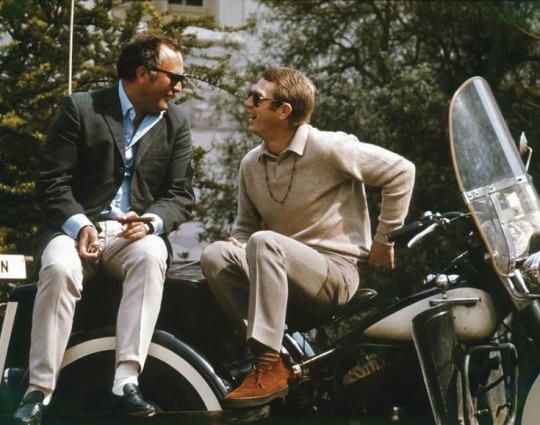

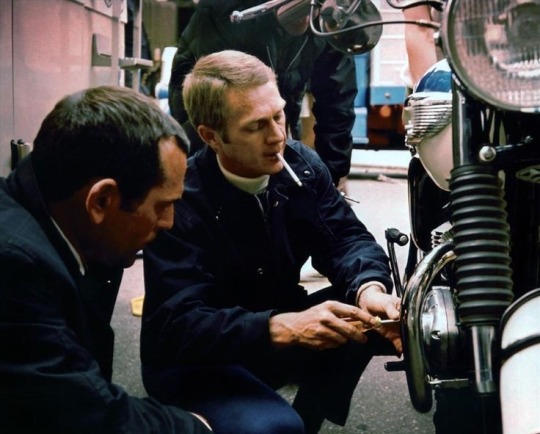

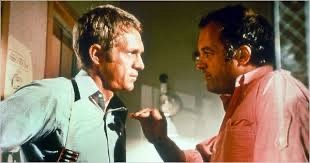
Director Peter Yates with Steve McQueen making BULLITT (1968)
49 notes
·
View notes
